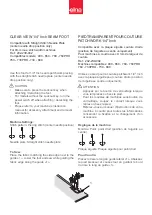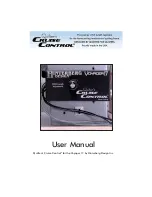
32
THE NEEDLE
BREAKS
STITCHES ARE
PUCKERED
STITCH
QUALITY
IS POOR
• Replace or correctly change the needle. Make sure that the needle is
pushed up into the needle bar clamp until it can go no farther (visu-
ally check that it is up to the top of the stop/sight opening above the
needle bar clamp screw). Failure to do so can cause damage in the
bobbin area and throat plate.
• Correctly position the needle, throat plate or hopping foot.
• Balance the tension of the needle thread after ensuring the bobbin
tension is adjusted correctly (refer to page 20).
• Replace the needle with a size better suited for the fabric.
• Adjust the tension of the needle thread if it is not balanced with that of
the bobbin thread.
• Since thread slides over the surface of the bobbin case at a high
speed, make sure the case is free of any material that could impede
thread passage through the machine.
• Synchronize machine movement and needle speed to get roughly
8-10 stitches per inch. Elongated stitches are an indication of moving
the machine too fast for the current speed.
• Clean the track and the rubber wheel on each stitch regulator. Even
a tiny speck on the wheel can cause problems with regulation. Check
the spring tension on each stitch regulator assemblies. If the retaining
nut is even slightly too tight it can prevent the wheel from properly
pressing against the track.
Problem
Cause
Correction
The needle is bent or
not installed properly
The needle hits the
throat plate
The tension is not
balanced
Needle too large for
material
The tension is not
balanced
Bobbin case is
damaged, corroded,
dirty, etc.
Moving the machine too
fast for needle speed
selected
Machine Stitch Regulator
wheels do not consistent-
ly touch the track
Содержание Crown Jevel BLCJ18
Страница 46: ...English BLCJ18 Printed in the USA...












































